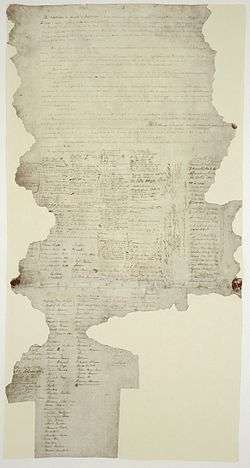Waitangi Day
Waitangi Day (Māori: Te Rā o Waitangi), the national day of New Zealand, marks the anniversary of the initial signing – on 6 February 1840 – of the Treaty of Waitangi, which is regarded as the founding document of the nation. The first Waitangi Day was not celebrated until 1934, and it was made a national public holiday in 1974.
| Waitangi Day | |
|---|---|
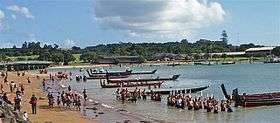 Traditional celebrations at Waitangi | |
| Observed by | New Zealanders |
| Type | National |
| Significance | Commemorates the signing of the Treaty of Waitangi, regarded as the nation's founding document |
| Observances |
|
| Date | 6 February |
| Frequency | Annual |
| First time | 1934 |
In present-day New Zealand, the anniversary is observed annually on 6 February and the day is usually recognised as a public holiday (unless the date falls on a Saturday or Sunday, when the Monday that immediately follows becomes the public holiday).[1] Ceremonies take place at Waitangi and elsewhere to commemorate the signing of the treaty. A variety of events are staged, including parties, Māori hui (social gatherings), reflections on New Zealand history, official awards and citizenship ceremonies. The commemoration has also been the focus of protest by Māori activists, and is often marred by controversy.
History
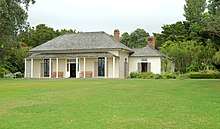
The Treaty of Waitangi was first signed on 6 February 1840 on the grounds of James Busby's house—now known as Treaty House—at Waitangi, in the Bay of Islands. The treaty was signed by representatives acting on behalf of the British Crown and, initially, about 45 Māori chiefs.[2] Over the course of the next seven months, copies of the treaty were toured around the country to give other chiefs the opportunity to sign.[3] The signing had the effect of securing British sovereignty over the islands of New Zealand, which was officially proclaimed on 21 May 1840.[4]
Previous celebrations
Prior to 1934, most celebrations of New Zealand's founding as a colony were held on 29 January, the date on which William Hobson arrived in the Bay of Islands to issue the proclamation of his appointment, which had been prepared by colonial office officials in England. Hobson had no draft treaty. From the British perspective the proclamation was the key legal document, "what the treaty said was less important".[5]
In 1932, Governor-General Lord Bledisloe and his wife purchased and presented to the nation the run-down house of James Busby, where the treaty was initially signed. They subsequently donated GB£500 to restore the building. The Treaty House and grounds were made a public reserve, which was dedicated on 6 February 1934.[6] This event is considered to be the first Waitangi Day.[7]
In 1940, another event was held at the grounds, commemorating the 100th anniversary of the treaty signing. The event was a success and helped raise the profile of the treaty and its day of observance in the national consciousness.[8]
Annual commemorations
Annual commemorations of the treaty signing began in 1947. The 1947 event was a Royal New Zealand Navy ceremony centring on a flagpole which the Navy had paid to erect in the grounds. The ceremony was brief and featured no Māori. The following year, a Māori speaker was added to the line-up, and subsequent additions to the ceremony were made nearly every year.[9] From 1952, the governor-general attended, and from 1958 the prime minister also attended, although not every year. From the mid-1950s, a Māori cultural performance was usually given as part of the ceremony. Many of these early features remain a part of Waitangi Day ceremonies, including a naval salute,[10] the Māori cultural performance (now usually a pōwhiri, a ceremonial welcome), and speeches from a range of Māori and Pākehā dignitaries.[11]
Proposed as public holiday
The Labour Party stated in its 1957 election manifesto that it would make Waitangi Day a public holiday. After winning that year's election, the party said that the country could not afford another public holiday. The Waitangi Day Act of 1960 allowed localities to transfer the holiday from their existing regional public holiday to Waitangi Day.[12]
In 1963, after a change of government, the passing of the Waitangi Day Amendment Act transferred the holiday observed in Northland on Auckland Anniversary Day (the Monday closest to 29 January) to Waitangi Day, 6 February. This made Waitangi Day a holiday in Northland only.[13]
Transition to public holiday

Waitangi Day became a nationwide public holiday on its observance in 1974 by first undergoing a name change. In 1971 the Labour shadow minister of Māori Affairs, Matiu Rata, introduced a private member's bill to make Waitangi Day a national holiday, to be called New Zealand Day. This was not passed into law.[14]
After the 1972 election of the third Labour government under Prime Minister Norman Kirk, it was announced that from 1974, Waitangi Day would be a national holiday known as New Zealand Day.[15] The New Zealand Day Act legislation was passed in 1973.[14] For Kirk, the change was simply an acceptance that New Zealand was ready to move towards a broader concept of nationhood. Diplomatic posts had for some years marked the day, and it seemed timely in view of the country's increasing role on the international stage that the national day be known as New Zealand Day.[14] At the 1974 commemorations, the Flag of New Zealand was flown for the first time at the top of the flagstaff at Waitangi, rather than the Union Flag, and a replica of the flag of the United Tribes of New Zealand was also flown.[16]
The election of the third National government in 1975 led to the day being renamed Waitangi Day because the new prime minister, Robert Muldoon, did not like the name "New Zealand Day" and many Māori felt that it debased the treaty. Another Waitangi Day Act was passed in 1976 to change the name back to Waitangi Day[17] and restore Northland's anniversary day holiday to that of Auckland.
Waitangi Day underwent 'Mondayisation' in legislation enacted in 2013, shifting the public holiday to Monday if 6 February falls on a Saturday or Sunday.[18]
Commemorations
At Waitangi

Commemorations at Waitangi usually commence the previous day, 5 February, at the Ngāpuhi marae Te Tii, when political dignitaries are welcomed onto the marae and hear speeches from the local iwi. These speeches often deal with the issues of the day, and vigorous and robust debate occurs.[19] Politicians are usually granted speaking rights, but on occasion, the privilege has been withdrawn, as with Leader of the Opposition Helen Clark in 1999,[20] Prime Minister John Key in 2016 (when one faction indicated it would even block him from entering the marae),[21] and Prime Minister Bill English in 2017.[22] In 2018, Jacinda Ardern was the first Prime Minister to attend the ceremony in three years.[23]
At dawn on Waitangi Day, the Royal New Zealand Navy raises the New Zealand Flag, Union Flag and White Ensign on the flagstaff in the treaty grounds. The ceremonies during the day generally include a church service and cultural displays such as dance and song. Several waka and a navy ship also re-enact the coming ashore of Governor Hobson to sign the treaty. The day closes with the flags being lowered by the Navy in a traditional ceremony.[19]
Elsewhere in New Zealand
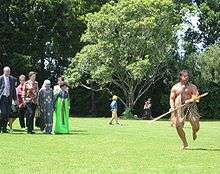
Some marae use the day as an open day and an educational experience for their local communities, giving them the opportunity to experience Māori culture and protocol, or as an opportunity to explain where they see Māori are and the way forward for Māori in New Zealand.[24][25] Commemorations are largely muted in comparison to those seen on the national days of most countries. There are no mass parades or firework displays, nor truly widespread commemorations.[26][27] At Government House in Auckland, citizenship ceremonies are usually held.[28] As the day is a public holiday, and coincides with the warmest part of the New Zealand summer, many people take the opportunity to spend the day at the beach – an important part of New Zealand culture.[29]
Since 2014, the New Zealand Society of Authors awards the Waitangi Day Literary Honours on Waitangi Day.[30]
In Australia
At the Kingston Butter Factory in Kingston, Queensland, Australia, the Te Korowai Aroha (Cloak of Love) Association held a multicultural festival to mark Waitangi Day annually from 2002.[31] In Sydney, an estimated 8,000 people attended the 2013 Waitangi Day Festival at Holroyd Gardens, Merrylands, an annual event in its fifth year. The festival featured displays of artefacts, performance of the haka, Māori cuisine and culture, tattooing and wood carving.[32] 6 February 2015 saw the inaugural Waitangi Day Commemoration held at Nurragingy Reserve, where the focus is more on the document itself, the Treaty process and the significance to Māori and Pākehā today. It was co-hosted by the Blacktown City Council and the New South Wales Māori Wardens.[33][34][35]
In the United Kingdom
In London, England, which has one of the largest New Zealand expatriate populations, the occasion is commemorated by the Waitangi Day Ball, held by the New Zealand Society UK. The focus of the event is a commemoration of New Zealand's unity and diversity as a nation. The Ball also hosts the annual UK New Zealander of the Year awards, cultural entertainment from London-based Māori group Ngāti Rānana and fine wine and cuisine from New Zealand. A service is also held by the society at the church of St Lawrence Jewry.[36]
A tradition, observed for more than 30 years as of 2016, takes place on the closest Saturday to 6 February: Kiwis participate in a pub crawl using the London Underground's Circle Line.[37][38]
Elsewhere in the world
In many other countries with a New Zealand expatriate population, Waitangi Day is commemorated privately. The day is officially commemorated by all New Zealand embassies and high commissions.[39]
For Waitangi Day 2007, Air New Zealand commissioned a number of New Zealanders living in Los Angeles and Southern California to create a sand sculpture of a silver fern on the Santa Monica Beach, creating a stir in the surrounding area.[40]
Controversy and protest
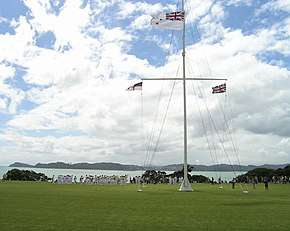
By 1971, Waitangi and Waitangi Day had become a focus of protest concerning treaty injustices, with Ngā Tamatoa leading early protests. Activists initially called for greater recognition of the treaty, but by the early 1980s, they were also arguing that it was a fraud and the means by which Pākehā had conned Māori out of their land. Attempts were made by groups, including the Waitangi Action Committee, to halt the commemorations.[41] This led to confrontations between police and protesters, sometimes resulting in dozens of arrests. When the treaty gained greater official recognition in the mid-1980s, emphasis switched back to calls to honour it, and protesters generally returned to the aim of raising awareness of it and what they saw as its neglect by the state.[42]
Some New Zealand politicians and commentators, such as Paul Holmes, have felt that Waitangi Day is too controversial to be a national day and have sought to replace it with Anzac Day.[43] Others, for example the United Future Party's Peter Dunne, have suggested that the name be changed back to New Zealand Day.[44]
Recent protests
.jpg)
Several hundred protesters often gather at Waitangi to reflect long-standing frustrations manifested among Māori since the signing of the treaty. Although not part of government commemorations, Māori-sovereignty activists often fly the Tino Rangatiratanga flag from the flagstaff. Attempts at vandalism of the flagstaff are often an objective of these protests, carrying on a tradition that dates from the 19th century when Hone Heke chopped down the British flagstaff in nearby Russell. In 2004, protesters succeeded in flying the Tino Rangatiratanga flag above the other flags on the flagstaff by flying it from the top of a nearby tree.[45]
Because of the level of protest and threats that had previously occurred at Waitangi, Prime Minister Helen Clark did not attend in 2000. The official commemorations were shifted from Waitangi to Wellington for 2001. Some Māori felt that this was an insult to them and to the treaty. In 2003 and 2004, the anniversary was again officially commemorated at the Treaty House at Waitangi. In 2004, Leader of the Opposition Don Brash was hit with mud as he entered the marae as a response to his controversial Orewa Speech that year.[46]
On 5 February 2009, the day before Waitangi Day, as then Prime Minister John Key was being escorted onto a marae, he was challenged and jostled by Wikitana and John Junior Popata, nephews of then Māori Party MP Hone Harawira.[47] Both admitted to assault and were sentenced to 100 hours of community service.[48] In 2011, Wikitana and John again heckled Key as he entered the marae.[49] A wet T-shirt thrown at Queen Elizabeth II[50] and other attacks on various prime ministers at Waitangi on 6 February have resulted in a large police presence and a large contingent of the armed forces. In 2016 a nurse protesting against the proposed signing of the TPPA trade agreement threw a rubber dildo at Steven Joyce, the MP representing Prime Minister John Key, who had refused to attend, having been denied normal speaking rights. The woman was arrested but later released.[51]
In 2018, Prime Minister Jacinda Ardern visited Waitangi for five days, the longest any prime minister has stayed. Titewhai Harawira, a Māori activist, greeted Ardern and escorted her onto the Treaty grounds holding hands, a significant change from her response to Helen Clark's visit in 1998, which brought Clark to tears. Ardern is also the first female prime minister to be given speaking rights on the marae by Ngāpuhi, who also offered to bury her child's placenta on the tribunal grounds.[52] Ardern was praised for her speech during her visit where she said "one day I want to be able to tell my child that I earned the right to stand here, and only you can tell me when I have done that".[53] Wally Haumaha, assistant commissioner, told the New Zealand Herald it was the best Waitangi Day commemoration he had attended in over a decade, saying, "I can retire gracefully and know that we saw this day where the government was treated with respect and dignity".[54]
See also
References
- "Extra public holidays voted in". Newshub. 17 April 2013. Retrieved 6 February 2018.
- Colenso, William (1890). The Authentic and Genuine History of the Signing of the Treaty of Waitangi. Wellington: By Authority of George Didsbury, Government Printer. Archived from the original on 16 August 2011. Retrieved 1 July 2018.
- "Creating the Treaty of Waitangi". Te Ara – The Encyclopedia of New Zealand. Retrieved 19 February 2016.
- "The Treaty in brief – Introduction". New Zealand History – nzhistory.govt.nz. Retrieved 10 February 2017.
- Before Hobson.pp 159–260 T. Simpson. Blythswood Press.2015.
- "Story: Bledisloe, Charles Bathurst". Te Ara – the Encyclopedia of New Zealand. Retrieved 8 February 2017.
- "Waitangi Day – Introduction". New Zealand History – nzhistory.govt.nz. Retrieved 9 February 2017.
- "Waitangi Day 1940s–1950s". New Zealand History – nzhistory.govt.nz. Retrieved 8 February 2017.
- "A brief history of Waitangi Day". New Zealand Herald. 5 February 2016. Retrieved 8 February 2017.
- "Navy to Have Large Presence at Waitangi" (Press release). Wellington, New Zealand: New Zealand Defence Force. 1 February 2018.
The first part of the ceremony will be performed by the RNZN Band, while the Royal Guard of Honour marches into position. […] At sunset the Guard will present arms and a single evening gun will be fired from the RNZN ship HMNZS Canterbury, which will be anchored off the Treaty grounds. A bugler will play Sunset over the evening hymn, during which time the New Zealand White Ensign will be lowered.
- "Politicians address iwi, hapū and whānau at the treaty grounds at Waitangi". RNZ. 4 February 2020. Retrieved 27 April 2020.
- "The 1960s – key events". New Zealand History – nzhistory.govt.nz. Retrieved 8 February 2017.
- "Waitangi Day – Waitangi Day 1960s". New Zealand History – nzhistory.govt.nz. Retrieved 8 February 2017.
- "Waitangi Day 1970s". New Zealand History – nzhistory.govt.nz. Retrieved 9 February 2017.
- "New Zealand Day at Waitangi | Television | NZ On Screen". www.nzonscreen.com. NZ On Screen. Retrieved 20 March 2018.CS1 maint: others (link)
- "Waitangi Day 1970s". New Zealand History – nzhistory.govt.nz. Retrieved 12 February 2017.
- Waitangi Day at NZhistory.net.nz
- "Extra public holidays voted in". 3 News NZ. 17 April 2013.
- "A brief history of Waitangi Day – What happens at Waitangi". NZ Herald. 5 February 2016. Retrieved 11 February 2017.
- "Clark's no-show at Waitangi a political risk". Stuff.co.nz. 5 February 2008. Retrieved 14 February 2017.
- "Prime Minister John Key's no-show at Waitangi 'no great loss'". Stuff.co.nz. 5 February 2016. Retrieved 14 February 2017.
- "PM Bill English defends Waitangi Day no-show, says Kiwis 'cringe' at protests". Stuff.co.nz. 9 January 2017. Retrieved 20 February 2017.
- "As it happened: 'Peaceful' Waitangi Day wraps up on Treaty Grounds". Newshub. 2 June 2018. Retrieved 20 March 2018.
- "Open marae for Waitangi Day". Otago Daily Times – odt.co.nz. 2 February 2017. Retrieved 18 February 2017.
- "Bill English attends Auckland marae for Waitangi Day celebrations after controversial weekend". TVNZ – tvnz.co.nz. 6 February 2017. Retrieved 18 February 2017.
- "Unity the message at Waitangi Day dawn service". Bay of Plenty Times. 6 February 2017. Retrieved 18 February 2017.
- "Gisborne Waitangi Day Celebrations 2015". ngatiporou.com. 6 February 2015. Retrieved 18 February 2017.
- "Waitangi Day Citizenship Ceremony" (Press release). Auckland, New Zealand: Office of the Governor-General. 6 February 2016.
- "A brief history of Waitangi Day – Modern Waitangi Day". NZ Herald. 5 February 2016. Retrieved 15 February 2017.
- "NZ Society of Authors Waitangi Day Honours List". mch.govt.nz. Ministry for Culture and Heritage. Retrieved 28 April 2020.
- "Explore our neighbour's culture". The Logan Reporter. 31 January 2012. Retrieved 13 February 2017.
- "Merrylands gets a taste of Maori Culture with the Waitangi Day Festival". Daily Telegraph (Australia) – dailytelegraph.com.au. 13 February 2013. Retrieved 16 February 2017.
- "And there he lies, ever, ever, the manuhiri". E-Tangata – A Māori and Pasifika Sunday magazine. 25 June 2017. Retrieved 20 March 2018.
- "Maori Wardens Australia | Unveiling the Pou – Nurragingy Reserve, Knox Rd Doonside". www.maoriwardensaustralia.com.au. Retrieved 20 March 2018.
- "Aboriginal elders object to Maori poles in Blacktown". NITV. Retrieved 20 March 2018.
- "St Lawrence Jewry February 2016 Newsletter" (PDF). Company of Distillers. February 2016. Retrieved 9 February 2016.
- "Waitangi Day celebratory scrum halts London traffic". Stuff.co.nz. 7 February 2016. Retrieved 20 February 2017.
- "Kiwis warned off drunk haka on Waitangi Day pub crawl". Stuff.co.nz. 5 February 2015. Retrieved 20 February 2017.
- "High Commission Closure: Waitangi Day" (Press release). Wellington, New Zealand: Ministry of Foreign Affairs & Trade Manatū Aorere. 2 February 2016.
The New Zealand High Commission in London will be closed on 8 February 2016 to observe Waitangi Day – New Zealand's national day which happens on 6 February every year. The office will reopen on 9 February. To all Kiwis far from home, kia kaha te whakanuia i to tatou ra o Waitangi.
- YouTube.com, Waitangi Day in Los Angeles
- Hazlehurst, Kayleen M. (1995), ‘Ethnicity, Ideology and Social Drama: The Waitangi Day Incident 1981’ in Alisdair Rogers and Steven Vertovec, eds, The Urban Context: Ethnicity, Social Networks and Situational Analysis, Oxford and Washington D.C., p.83; Walker, Ranginui (1990), Ka Whawhai Tonu Matou: Struggle without End, Auckland, p.221.
- "A brief history of Waitangi Day – "Not everyone has something to celebrate"". NZ Herald. 5 February 2016. Retrieved 11 February 2017.
- Paul Holmes (11 February 2012). "Waitangi Day a complete waste". The New Zealand Herald. Retrieved 13 February 2012.
- "United Future press release". UnitedFuture. 5 February 2007.
- "Maori flag flies over Waitangi". TVNZ. 6 February 2004. Retrieved 20 March 2018.
For the first time ever the Maori sovereignty flag has flown higher than the official New Zealand flag at Waitangi. A young Northland Maori activist climbed a 40-metre monkey puzzle tree on the Waitangi treaty grounds on Friday afternoon and fixed the black and red tino rangitiratanga flag to the top, well above the nearby naval flagstaff. He climbed down to tumultuous applause and a triumphant haka.
- "Mud thrown at Brash at marae". The New Zealand Herald. 5 February 2004. Retrieved 1 December 2011.
- Trevett, Claire (6 February 2009). "Elders condemn attack on PM". The New Zealand Herald.
- "Brothers sentenced for assaulting John Key". The New Zealand Herald. NZPA. 12 June 2009. Retrieved 1 December 2011.
- Yvonne Tahana & Claire Trevett (5 February 2011). "Harawira proud of nephew's protest". The New Zealand Herald. with NZPA. Retrieved 1 December 2011.
- David V. James; Paul E. Mullen; Michele T. Pathé; J. Reid Meloy; Frank R. Farnham; Lulu Preston & Brian Darnley (2008). "Attacks on the British Royal Family: The Role of Psychotic Illness" (PDF). J Am Acad Psychiatry Law. 36: 59–67.
- "New Zealand MP 'Dildo Baggins' cops sex toy in the face and takes ribbing on the chin". The Guardian. 16 February 2016. Retrieved 13 February 2017.
- Ainge-Roy, Eleanor (6 February 2018). "Jacinda Ardern defuses tensions on New Zealand's sacred Waitangi Day". the Guardian. Retrieved 23 May 2018.
- Ainge-Roy, Eleanor (6 February 2018). "Jacinda Ardern defuses tensions on New Zealand's sacred Waitangi Day". the Guardian. Retrieved 23 May 2018.
- Ainge-Roy, Eleanor (6 February 2018). "Jacinda Ardern defuses tensions on New Zealand's sacred Waitangi Day". the Guardian. Retrieved 23 May 2018.
External links



- A history of Waitangi Day at NZHistory.net.nz
- WaitangiTribunal.govt.nz, introducing the Treaty of Waitangi
- The Waitangi Collection at NZ On Screen
